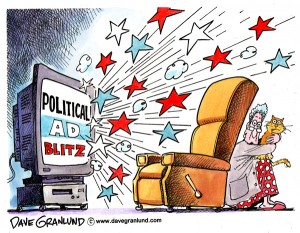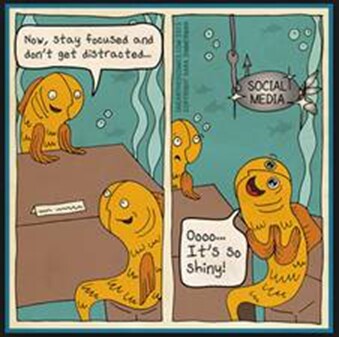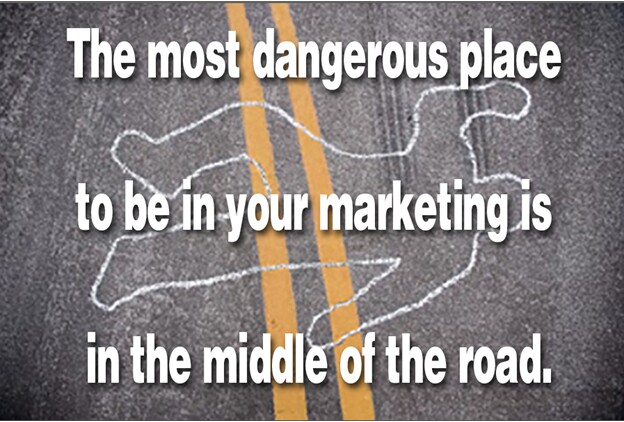 As a partner in a thriving marketing firm that targets companies with $20-$100 million in annual sales, one of my responsibilities is that of business development. While I learn something in each conversation with people in marketing leadership positions, many times after I hang up the phone, I say to myself, “there’s another one who’s losing sales to their competitors!” Mainly that’s because these folks have adopted some misconception about marketing as the “truth” that they can’t and won’t let go of no matter what. So while they say they’d like their sales to be stronger, their year-over-year sales won’t change much or, in some cases, will decrease from one year to the next.
As a partner in a thriving marketing firm that targets companies with $20-$100 million in annual sales, one of my responsibilities is that of business development. While I learn something in each conversation with people in marketing leadership positions, many times after I hang up the phone, I say to myself, “there’s another one who’s losing sales to their competitors!” Mainly that’s because these folks have adopted some misconception about marketing as the “truth” that they can’t and won’t let go of no matter what. So while they say they’d like their sales to be stronger, their year-over-year sales won’t change much or, in some cases, will decrease from one year to the next.
So, let’s do a quick run-through of 5 most common fallacies that I hear. Hopefully none of these sound as familiar to you as they do to me.
I can grow my sales and “share of pie” with a smaller budget than my competitors
When I hear this, it generally implies two things to me: 1) Either your competitors are wasting a big portion of their marketing budget on initiatives or messaging that doesn’t connect with the customers or, 2) your marketing partners are fantastic because they’re willing to work for less than the average market price in order to do the wonderful work they do…which I have a hard time believing is the case. Oh, and then let’s not forget about the inability of these companies to track how much money the competitor is actually (over) spending on marketing.
The reality is this: if your company is spending a good deal less than the competition, you’re probably not making any significant gains in market share. Yes, there might be a competitor that’s overspending, but my experience working with companies from the Fortune 100 to small mom-and-pops is that you don’t pose a serious competitive threat unless your marketing budget is in the same ballpark with your competition….it’s just one of those “marketing truths.”
Marketing’s role is to generate new business
You’ll get no argument from me that one of the jobs of marketing is to generate new business, directly or indirectly. But just as important, marketing’s role is to make existing customers come back for more, that is making customers loyal to the brand. Many businesses are so focused on attracting new customers that they tend to ignore – or even walk away from – the existing ones. Yes, new customers are constantly needed, but truly successful companies prosper on their ability to retain the customers they’ve already acquired. The reason is simple: finding new customers is expensive and time-consuming. Let the following research statistics wash over you….
- The cost of acquiring a new customer is estimated at 6 to 7 times what it costs to maintain a current one.
- The probability of selling to an existing customer is 60 – 70% while many companies consider a “get new customers” campaign successful if just over 5% of the prospects contacted end up buying.
New business is always good but don’t forget who’s paying the bills.
We’re looking to be more visible with our customers because it leads to better engagement
Reaching the right balance between quality and frequency of the message requires careful consideration. There is a common belief among some that the more we communicate with our customers, the more “engaged” they will become. In fact, not knowing when to “zip it” is a classic marketing mistake that too many marketing people make. If marketing is about building relationships with customers, over-marketing is the best way to kill the relationship and send the customer or prospect heading for the door. A social engagement study entitled “The Social Breakup” prepared by ExactTarget, provides clear evidence of what happens to customer relationships when the marketer comes on too strong:
- 91% of consumers have unsubscribed from permission-based marketing emails
- 81% of consumers have either “unliked” or removed a company’s posts from their Facebook.
Guess the biggest reason people break up with companies? (Drum roll)…Too much marketing. The study showed that:
- 54% of consumers unsubscribe when emails come too frequently;
- 63% of customers have “unliked” a company on Facebook due to excessive postings.
In short, increasing the frequency of communication shouldn’t be your marketing goal. Constantly improving content quality should be.
We don’t need a marketing firm because we can do it in-house for less
It’s the #1 thing I hear the most. A survey conducted by American Express Canada shows that “84% of small business owners say branding is important to overall business success, but only 14% hire third-party experts to help with branding.” I am not surprised by the results, and I can only guess the reasons: agency expense, the desire to have full control over the creative process, poor prior experience with an agency, or possibly the ability to make changes faster on one’s own. So, instead of looking for an outside marketing partner, many companies decide to hire a “marketing person” who wears many hats: graphic designer, social media specialist, copywriter, etc. Let’s be honest, no marketer can be a specialist in everything, unless the company is willing to cut corners on how it presents itself to the world.
Now please understand, I’m not trying to bash the in-house marketing department as there are a lot of smart and talented people out there working for companies. Rather, my point is this: the right outside marketing partner will bring a focus to the marketing initiatives or project, resulting in faster execution time; will come in with an original point of view – more in line with how your customer will interpret the messaging; develop much fresher creative (no “vanilla” wallpaper stuff that gets passed over, and; deliver a much higher level of production quality. Try this on for size: open up 5 trade or consumer magazines and tag or cutout 10 ads that stop you in your tracks… ones that convey a strong value proposition, ones that you wish your firm had done! My completely biased but nevertheless absolutely accurate guess is that all 90% of those ads you clipped out were created by a marketing or advertising agency.
We’re looking for something beyond traditional marketing because that kind of advertising is dead
The internet is chock full of advice on how your company should abandon traditional “old school” communication methods and make the switch to online. It would seem like TV, print ads, billboards, and radio are dying and not worth considering in the overall communication strategy. Yet, research (and lots of it) say this is an incorrect assumption. I think we can agree that the best marketing communication strategy uses a mix of offline and online tactics to reach the target audience. (Do yourself a favor and visit www.marketingcharts.com and subscribe –it’s free. Here you’ll get daily research updates on a wide range of topics including how traditional channels are preferred over digital depending on the audience.)
While it’s true that more money is shifting towards digital, the traditional marketing channels are still heavily required in many business environments. In fact, when Google started getting serious competition, they started running…wait for it…TV ads! When Dollar Shave Club saw that their growth was limited by only online marketing, they started using those old, traditional channels that have in turn made them a rising star company. When there’s a product launch, a sale or just about any other occasion where you need to reach a mass audience quickly and effectively, there’s still no substitute for paid media…and even the dot-coms know it. Think about this, in 2014, the average cost of a 30-second Super Bowl ad was more than $4 million. No CEO or Marketing Director would ever approve such a budget without taking ROI into account, right?
So as I noted earlier, hopefully none of these sound familiar to you. But if on the other hand you’ve heard or said one of these things in the past, know that a lot of confusion, frustration and unrealistic expectations can be eliminated by seeing the world through a different set of lenses.
####
Rolf Gutknecht is vice president, director of account services for LA ads. To discuss your thoughts with Rolf on this blog or any marketing matters, email via this link, or visit www.LAadsMarketing.com. You can also connect with Rolf on LinkedIn.

 I’m so glad it’s over. Probably like you, my home phone was being called at an increasing rate the closer that we got to Election Day. Candidates’ faces and names were everywhere and on everything from direct mail to lawn signs and outdoor boards to TV and radio commercials. As annoying as it was, there were a number of messaging strategies and tactics that caught my attention because they were executed exceedingly well, which, as marketers, we should consider adding to our communication toolkits for use tomorrow, next week or next month. For as we all know, your customer and prospects are still being bombarded with marketing messages each and every day by both you and your competitors.
I’m so glad it’s over. Probably like you, my home phone was being called at an increasing rate the closer that we got to Election Day. Candidates’ faces and names were everywhere and on everything from direct mail to lawn signs and outdoor boards to TV and radio commercials. As annoying as it was, there were a number of messaging strategies and tactics that caught my attention because they were executed exceedingly well, which, as marketers, we should consider adding to our communication toolkits for use tomorrow, next week or next month. For as we all know, your customer and prospects are still being bombarded with marketing messages each and every day by both you and your competitors. A couple of weeks ago, I was at a trade show and after walking up and down the aisles, it occurred to me just how much of the same-old, same-old I was seeing. Nothing really new (unless you consider irrelevant modifications like changing the color from blue to orange and different shaped bottles as new). There was nothing that I can say showed me that companies were spending any amount of time and energy in looking at the marketplace with an eye toward identifying the opportunities that trends in customer purchasing or behavior would present.
A couple of weeks ago, I was at a trade show and after walking up and down the aisles, it occurred to me just how much of the same-old, same-old I was seeing. Nothing really new (unless you consider irrelevant modifications like changing the color from blue to orange and different shaped bottles as new). There was nothing that I can say showed me that companies were spending any amount of time and energy in looking at the marketplace with an eye toward identifying the opportunities that trends in customer purchasing or behavior would present. As a partner in a thriving marketing firm that targets companies with $20-$100 million in annual sales, one of my responsibilities is that of business development. While I learn something in each conversation with people in marketing leadership positions, many times after I hang up the phone, I say to myself, “there’s another one who’s losing sales to their competitors!” Mainly that’s because these folks have adopted some misconception about marketing as the “truth” that they can’t and won’t let go of no matter what. So while they say they’d like their sales to be stronger, their year-over-year sales won’t change much or, in some cases, will decrease from one year to the next.
As a partner in a thriving marketing firm that targets companies with $20-$100 million in annual sales, one of my responsibilities is that of business development. While I learn something in each conversation with people in marketing leadership positions, many times after I hang up the phone, I say to myself, “there’s another one who’s losing sales to their competitors!” Mainly that’s because these folks have adopted some misconception about marketing as the “truth” that they can’t and won’t let go of no matter what. So while they say they’d like their sales to be stronger, their year-over-year sales won’t change much or, in some cases, will decrease from one year to the next.






